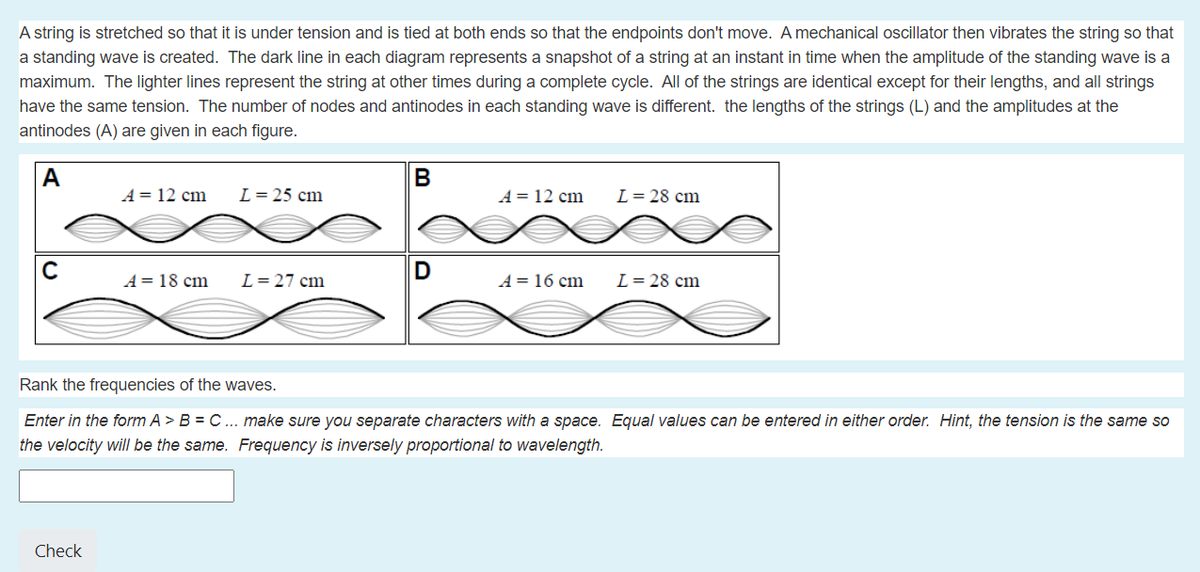A string is stretched so that it is under tension and is tied at both ends so that the endpoints don't move. A mechanical oscillator then vibrates the string so that a standing wave is created. The dark line in each diagram represents a snapshot of a string at an instant in time when the amplitude of the standing wave is a maximum. The lighter lines represent the string at other times during a complete cycle. All of the strings are identical except for their lengths, and all strings have the same tension. The number of nodes and antinodes in each standing wave is different. the lengths of the strings (L) and the amplitudes at the antinodes (A) are given in each figure. A A = 12 cm L= 25 cm A = 12 cm L= 28 cm A= 18 cm L= 27 cm A = 16 cm L= 28 cm Rank the frequencies of the waves. Enter in the form A > B = C ... make sure you separate characters with a space. Equal values can be entered in either order. Hint, the tension is the same so the velocity will be the same. Frequency is inversely proportional to wavelength.
A string is stretched so that it is under tension and is tied at both ends so that the endpoints don't move. A mechanical oscillator then vibrates the string so that a standing wave is created. The dark line in each diagram represents a snapshot of a string at an instant in time when the amplitude of the standing wave is a maximum. The lighter lines represent the string at other times during a complete cycle. All of the strings are identical except for their lengths, and all strings have the same tension. The number of nodes and antinodes in each standing wave is different. the lengths of the strings (L) and the amplitudes at the antinodes (A) are given in each figure. A A = 12 cm L= 25 cm A = 12 cm L= 28 cm A= 18 cm L= 27 cm A = 16 cm L= 28 cm Rank the frequencies of the waves. Enter in the form A > B = C ... make sure you separate characters with a space. Equal values can be entered in either order. Hint, the tension is the same so the velocity will be the same. Frequency is inversely proportional to wavelength.
Elements Of Electromagnetics
7th Edition
ISBN:9780190698614
Author:Sadiku, Matthew N. O.
Publisher:Sadiku, Matthew N. O.
ChapterMA: Math Assessment
Section: Chapter Questions
Problem 1.1MA
Related questions
Question

Transcribed Image Text:A string is stretched so that it is under tension and is tied at both ends so that the endpoints don't move. A mechanical oscillator then vibrates the string so that
a standing wave is created. The dark line in each diagram represents a snapshot of a string at an instant in time when the amplitude of the standing wave is a
maximum. The lighter lines represent the string at other times during a complete cycle. All of the strings are identical except for their lengths, and all strings
have the same tension. The number of nodes and antinodes in each standing wave is different. the lengths of the strings (L) and the amplitudes at the
antinodes (A) are given in each figure.
А
В
A = 12 cm
L= 25 cm
A = 12 cm
L= 28 cm
C
D
A= 18 cm
L= 27 cm
A = 16 cm
L= 28 cm
Rank the frequencies of the waves.
Enter in the form A > B = C ... make sure you separate characters with a space. Equal values can be entered in either order. Hint, the tension is the same so
the velocity will be the same. Frequency is inversely proportional to wavelength.
Check
Expert Solution
This question has been solved!
Explore an expertly crafted, step-by-step solution for a thorough understanding of key concepts.
This is a popular solution!
Trending now
This is a popular solution!
Step by step
Solved in 2 steps with 2 images

Knowledge Booster
Learn more about
Need a deep-dive on the concept behind this application? Look no further. Learn more about this topic, mechanical-engineering and related others by exploring similar questions and additional content below.Recommended textbooks for you

Elements Of Electromagnetics
Mechanical Engineering
ISBN:
9780190698614
Author:
Sadiku, Matthew N. O.
Publisher:
Oxford University Press

Mechanics of Materials (10th Edition)
Mechanical Engineering
ISBN:
9780134319650
Author:
Russell C. Hibbeler
Publisher:
PEARSON

Thermodynamics: An Engineering Approach
Mechanical Engineering
ISBN:
9781259822674
Author:
Yunus A. Cengel Dr., Michael A. Boles
Publisher:
McGraw-Hill Education

Elements Of Electromagnetics
Mechanical Engineering
ISBN:
9780190698614
Author:
Sadiku, Matthew N. O.
Publisher:
Oxford University Press

Mechanics of Materials (10th Edition)
Mechanical Engineering
ISBN:
9780134319650
Author:
Russell C. Hibbeler
Publisher:
PEARSON

Thermodynamics: An Engineering Approach
Mechanical Engineering
ISBN:
9781259822674
Author:
Yunus A. Cengel Dr., Michael A. Boles
Publisher:
McGraw-Hill Education

Control Systems Engineering
Mechanical Engineering
ISBN:
9781118170519
Author:
Norman S. Nise
Publisher:
WILEY

Mechanics of Materials (MindTap Course List)
Mechanical Engineering
ISBN:
9781337093347
Author:
Barry J. Goodno, James M. Gere
Publisher:
Cengage Learning

Engineering Mechanics: Statics
Mechanical Engineering
ISBN:
9781118807330
Author:
James L. Meriam, L. G. Kraige, J. N. Bolton
Publisher:
WILEY